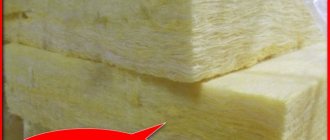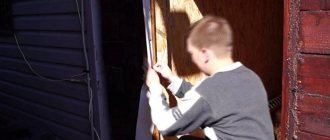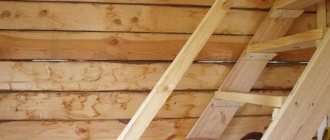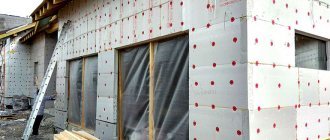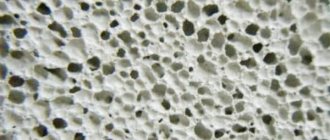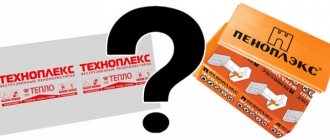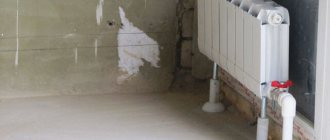Comfortable living is ensured not only by the availability of utilities and the design of the premises. It is important to protect the house from heat loss, which is important during the cold season. Doors and windows are powerful sources of cold air entering the home. There are several ways to keep your room warm.
Replace doors with energy-saving designs. This is not cheap and involves related operations to design slopes, install platbands, etc. In many cases, it is possible to solve this problem in affordable ways without significant costs. One of the traditional insulation materials is felt door seal, which has both disadvantages and advantages.
Advantages of felt seals
Today, manufacturers offer a new generation of materials that are easy to install and affordable. The share of felt products is decreasing, but it is too early to abandon their use, since they have a number of special qualities:
- Wear resistance. Natural fibers can withstand significant physical stress without deteriorating.
- Life time. Unlike rubber and foam seals, felt does not contain volatile substances, the content of which steadily decreases during operation. This leads to destruction of the material and requires replacement. Felt seals do not lose their properties for many years.
- Soundproofing. The material absorbs vibrations. Both outside noise and the sounds of the door in contact with the frame are dampened.
- Environmental friendliness. Only natural raw materials are used in production. There is no release of substances harmful to health.
- Fire safety. The density of wool fibers and their quality are such that combustion is impossible under normal conditions.
Ready-made felt seal for doors
Disadvantages of felt seals
Previously, felt was used everywhere as insulation and sealant. It was considered the best material for these purposes. Why is this method of protecting your home from the cold inferior? Despite the fact that the user qualities of felt are not in doubt, there are also disadvantages:
- Price. Production refers to traditional technologies with a centuries-old history. Felt is made from natural wool. During hydrothermal treatment, fibers are pressed into sheet or roll material. The cost of raw materials and labor create a price that is higher than synthetic fiber of similar size.
- Difficult to install. It is difficult to find a felt seal that satisfies most requirements on sale. All operations require an individual approach and qualifications. The range of felt materials is limited. You need to independently cut the strips of the required width and choose the method of fixation.
Rolled felt
- Attractive to moths and mice. Unlike microorganisms and mold, which do not live in felt, rodents and some types of insects like the material. Moths perceive felt as a food product, and mice insulate their minks with it.
Attention! When purchasing, you should carefully read the information about the product on the packaging or in accompanying documents. Natural felt is 100% wool. There are materials on sale with a similar name, but they cannot be considered as such. In cases where the percentage of natural fiber content is indicated in the composition, and even more so when it is absent there.
Using felt
Artificial insulation materials are becoming cheaper and easier to install. Therefore, demand for traditional natural materials such as felt is gradually falling.
Felt has increased wear resistance and retains its thermal insulation properties for a long time. Analogs made from artificial materials deteriorate faster. They contain volatile substances that evaporate over time. Such insulation needs frequent replacement.
Felt insulation insulates extraneous noise well due to its ability to dampen vibrations. This property extends to external sounds and the knock of the door on the frame.
Materials made from pure wool are environmentally friendly and do not pollute the air with harmful emissions. Felt is fire resistant. The wool is so dense that the risk of fire is minimized.
Before the advent of cheap artificial analogues, felt was widely used as door insulation. The material has disadvantages that force the choice of synthetic insulation.
Felt is a completely natural material. It consists of natural wool that undergoes complex processing. Its fibers are compacted under high pressure and formed into rolls and sheets. The technological process is complex, which explains the high price of the material. The production of synthetic materials is much cheaper. Their cost is more attractive to the consumer.
Another disadvantage is the difficulty of installing felt insulation. An unprofessional repairman cannot handle this matter on his own. Felt attracts moths and mice. It harbors microorganisms, insects and mold.
Any type of felt found on sale is suitable as insulation for the front door. It is worth paying attention to the thickness of the material, which ensures sufficient tightness of the seal.
Felt can be nailed down with nails. But it is more convenient to fasten it with a stapler. If the material needs to be fixed to a metal surface, glue is used. It is not recommended to use double-sided tape due to its low bond strength.
The glue is applied in two layers. The first is needed to saturate the loose top layer of felt. After it dries, apply a second layer of glue and attach the material to the surface of the door.
Types of felt seals
The production of the material is localized in regions that traditionally produce wool products. Classic technology is rooted in the distant past and has secrets. Not all developed countries know how to make felt. In Russia, production secrets have not been lost, and the products enjoy well-deserved respect. Despite the fact that the manufacturing process is traditional, the quality of the products is regulated by state standards. The consumer can choose the desired felt from the following types:
- GOST 288-72. Fine-wool technical felt. Inclusion of synthetic substances is allowed. Its main application is in technology. Gaskets and seals made of this material are used in mechanical engineering;
- GOST 6308-71. Semi-coarse technical felt. Excellent wear resistance. Used in mechanical engineering and in small quantities in construction;
- GOST 6418-81. Coarse wool technical felt. Used in many areas of economic activity. From mechanical engineering to construction;
- GOST 16221-79. This type of felt is called yurt. The name corresponds to the purpose of the material. Available in the form of rectangular cavities. There is no single standard. Allowed length is from 2 to 6 m, and width is from 1.4 to 2 m;
- Felt. It is used for technical purposes and in the production of household items and clothing. Expensive type of felt. Produced in thicknesses from 2 to 10 mm. Felt padding is made from old items such as hats or anti-shock layers removed from packaging and is used to transport fragile, valuable instruments and devices.
Automotive soundproofing felt
Any felt is used as a door seal. The minimum required thickness should be taken into account. The dynamic compression coefficient of felt is limited. For this reason, the difference in gap width should not exceed 2-3 mm. Otherwise, the door leaf rebate will not be airtight, the seal will be partial and the protection will not be effective.
Advice! If the width of the gap is uneven, you can pre-fill places with a large gap with pieces of felt of the required thickness. It is easy to cut lengthwise. After preliminary leveling, the finishing felt strip is installed. Another option involves installing a felt seal with the end side relative to the plane of the door. In this case, it is effective to form a roller.
The main features of felt for thermal insulation
It must be said right away that felt is often used to insulate wooden houses. It is in this case that the material demonstrates good efficiency. If we use felt in other conditions, then it will also show itself from a good side, but there will also be some flaws, which we will talk about a little later.
Many builders consider the strength of felt to be the absence of the need for additional treatment of the surfaces of the home. This significantly shortens the entire repair process, and also allows you to forget about the integrity of the finish, which can collapse in various situations.
Due to the fact that this insulating material is relatively inexpensive, it can be laid in several layers. This will also increase the efficiency of the felt, and at the same time we will save a lot of money by not having to buy modern thermal insulation materials.
Unfortunately, felt cannot be used in all climatic conditions. You should first learn about this from specialists who offer felt products. In this regard, the material is more demanding than others.
When do you need to insulate?
Wood has low thermal conductivity, but the disadvantage of the material is its response to changes in humidity and temperature. The door block dries out, swells, warps and even cracks. There are three main reasons signaling the urgent need to insulate a wooden door in a country house:
- Formation of gaps between the frame and the ends of the opening walls . Initially, during installation work, all gaps are foamed. Foam is a good insulator, but over time it loses its properties. Destruction occurs faster on the street side if platbands are not installed. Foam deteriorates from exposure to the sun. Another cause of cracks is the misalignment of the bowl.
- Formation of gaps between the frame and the sash . The most common defect in a wooden entrance door occurs due to poor wood, poor-quality installation and long-term use. Often the owner himself becomes the culprit when he trims the swollen sash so that it closes better. After drying, the product decreases in size and a gap forms.
- Wear of insulation. Each thermal insulation material is selected taking into account operational requirements. If they were not initially followed, the incorrectly selected insulation loses its effectiveness. For example, mineral wool quickly cakes, and due to dampness it decreases in volume. Any old wooden door, as well as a thin leaf, needs to be insulated.
Do I need to insulate the door?
The properties of heat preservation, protection from the penetration of noise, odors from the outside, and protection from drafts are provided by manufacturers of entrance doors at the design development stage. A decrease in the ability of a structure to retain heat is detected for a number of reasons.
Warm air leaks occur due to severe wear of the insulation located between the sheets and the appearance of gaps caused by deformation of the box or sheet. This happens due to frequent use of the door, installation errors or high humidity.
Heat loss is facilitated by the formation of cracks due to the fact that the doorway is larger than the frame. Usually this defect is eliminated with polyurethane foam. When its layer is not uniform, cold air penetrates through the gaps.
Which insulation is better to choose?
To make an insulated wooden door with your own hands, you will need thermal insulation material, as well as material for the top decorative finish. The gaps are sealed with a sealant. When the question arises of how to insulate a wooden door in a private house, pay attention to the following materials:
- polystyrene foam as internal insulation for wooden entrance doors. The slabs can be sheathed on the side of the room.
- Foam rubber is considered the most common insulation material, which is covered with artificial leather on top. Porous material allows you to create a volume effect. Foam rubber loses over time and crumbles into crumbs.
- Mineral wool does not burn, has good thermal insulation properties, but quickly cakes. When exposed to dampness, it accumulates moisture. Under the weight it slides off a vertical surface.
- Foamed polyethylene - isolon has a structure similar to foam rubber. The material has better thermal insulation properties and a longer service life. Isolon does not tolerate long-term exposure to direct sunlight.
- Polyurethane foam is applied by spraying, firmly adheres to the wood, and penetrates into all cracks. The disadvantage is the impossibility of performing work without special equipment.
- Expanded polystyrene resembles polystyrene foam, but has improved characteristics. The material has self-extinguishing properties when exposed to open fire.
When choosing insulation for the doors of a wooden house, it is important to consider the thickness of the material. Thick layers will weigh down the sash and create an obstacle to normal closing. Thin is useless. You need to find a middle ground between these two parameters.
Types of seals for door frames
In addition to thermal insulation, you will need a sealant to seal the cracks around the perimeter of the canvas. It is a tape that differs in thickness and material:
- The foam strip is fixed using an adhesive base. The seal wears out quickly during the season.
- The silicone strip is resistant to dampness and elastic. Over time, it begins to stick and tear into pieces.
- The rubber seal for wooden doors will last for many years. The tape is resistant to wear, dampness, and mechanical stress.
- Thermoplastic is the best in terms of wear resistance, but is difficult to install.
- The polyurethane strip is glued due to the adhesive base. The characteristics are not inferior to a rubber seal.
Thermal insulation cannot be done without decorative finishing. Usually the insulation is covered with artificial leather. Fixed with furniture nails with a wide decorative head. On the inside, the canvas is sheathed with laminated MDF panels. Genuine leather trim looks beautiful, but the material is very expensive.
How to insulate a wooden door?
The insulation of a wooden door begins with preparatory work :
- weakened hinges are secured with new elongated screws;
- if thick, heavy insulation is used, install an additional loop;
- eliminate box distortions and fabric defects;
- check the condition of the seal around the perimeter of the door frame at the junction with the walls;
- replace broken fittings: lock, handles, peephole, latch.
After all defects have been eliminated, installation of insulation on wooden entrance doors begins.
a vapor barrier necessary when insulating wooden doors? When arranging the installation seams of the door block - it is necessary. The gap between the box and the wall is sealed with foam. To prevent the thermal insulation from deteriorating, the seam is covered from the street with PSUL tape. From the room side, the foam is destroyed by vapors. For protection, the seam is sealed with vapor barrier tape. A vapor barrier may be required for the product if it is installed in a damp room and mineral wool serves as thermal insulation.
Installation of double doors
A good way to insulate your home is to install a double entry door. Due to the formation of an air space separating the room from the street, heat is retained. The disadvantage of this design is the reduction in space.
A threshold is set for the indoor unit. Insulation is additionally laid on the slopes between the doors. There are designs where two doors are hinged on one deep frame.
When insulating entrance doors, you must remember that moisture affects the canvas from the street side. Treatment with impregnation, painting with paint or varnish will help protect against dampness as much as possible. Drying oil creates good waterproofing.
Felt comes in rolls and sheets.
In one of the earlier articles, we introduced you to how to insulate a bathroom. Today we will talk about a very old, but, unfortunately, insulation made from natural sheep wool, which has lost its popularity - felt. This material is ideal for insulating doors, window and door frames, and the crowns of log houses. But if you want to completely isolate your house with it, you will encounter many problems, solutions for which are extremely difficult to find. “There are no hopeless situations,” said the notorious Baron Munchausen, but despite this, there is still no developed clear method for insulating walls with felt.
What kind of felt insulation for doors is there?
What a pity that this excellent, natural material with excellent characteristics is almost forgotten. Today, felt is used to insulate doors and window openings. In ordinary houses, this is where it ends, but if we are talking about wooden structures or a bathhouse from a log house (timber), then it is also used as inter-crown insulation and for caulking cracks. And probably no one even knows that felt insulation comes in different forms:
- technical fine-haired – manufactured in accordance with GOST No. 288-72;
- technical semi-coarse wool – manufactured in accordance with GOST No. 6308-71;
- technical coarse-haired – manufactured in accordance with GOST No. 6418-81;
- yurt - manufactured in accordance with GOST No. 16221-79;
- fert - made from the finest fibers of six rabbits and goats.
Felt insulation has a fairly low thermal conductivity, the coefficient is 0.03-0.07 W/m*K and depends on the density of the material. The latter varies in the range from 10 to 400 kg/m. cube
The material is produced both in panels and in rolls. The dimensions of the panels are 2000 x 2000 mm, rolls are up to 1800 mm wide and up to 200 m long. It is made from both natural and synthetic raw materials. Synthetics are already a trend of modernity; you shouldn’t take them seriously, but natural materials deserve attention.
This is a crown seal made of 15% felt.
How to use felt material for wall insulation?
Most often it is used for insulation of wooden houses. Wood itself retains heat well, and with proper insulation, the house will be constantly warm even in the most severe cold weather.
For a house made of timber, inter-crown insulation is one of the best options, allowing you to do without additional wall decoration and at the same time keep the house warm.
How to choose felt-based insulation?
The thickness of the thermal insulation layer will depend on the climate and the type of timber used. If laminated timber was chosen as the material for construction, then the felt tape must have a thickness of at least 6 mm.
If a rounded log was used, then from 8 to 10 mm. The thickest layer of insulation is required for houses made of ordinary chopped logs - up to 15 mm.
Felt for log houses
Most often, jute or linen inter-crown felt is used for walls. Flax fiber (also called Euroflax) is sold in rolls, the width of which can vary. This heat insulator is made from flax fibers of approximately the same length, thanks to which it easily fills all the cracks and does not require any additional processing.
Jute fiber has similar properties and is widely used for wooden buildings. It also provides good thermal insulation, is highly durable and is not afraid of dampness. Both materials are equally suitable for insulating houses made of glued or profiled timber, as well as buildings built from logs.
How is wall insulation carried out?
Distribution of insulation along the timber
The walls are insulated directly during the construction of a wooden building.
Sample instructions:
- Before construction, the perimeter of the house, the number of crowns - used logs or beams, possible gaps between them and, accordingly, the amount of tape insulation required;
- During construction, the insulation is rolled out over the laid timber, with the edge protruding slightly.
Advice! If uneven or misaligned timber is used, then the insulating tape must be folded in two layers, since the gaps will be larger and need to be completely filled.
- The insulation tape is attached to the log using a construction stapler. The staples will not allow it to slide or get out from behind the beam when pressure increases from above;
Attaching felt insulation
- Excess tape is cut off to give the building a neat appearance. The photo shows how the insulation can be positioned to achieve maximum effect.
Placing insulation in 2 layers
Placement of insulation with a bend
How to insulate a bathhouse door with felt
Most often, felt is used to insulate door and window frames, as well as for external door insulation. The fact that the material is environmentally friendly and that it breathes allows it to be used even in baths at high temperatures and humidity. Let's look at insulating a bathhouse door with felt from two angles. The first will be the insulation of the box.
This technique is applicable for both entrance doors and the entrance to the steam room. In both cases, insulation for felt doors is laid around the perimeter of the frame at the junction with the movable part. To do this you need:
- roll the felt into a small roll;
- on the side where the edge is visible, the roll is laid around the perimeter of the box;
- fastened with nails or a stapler.
No additional protection is needed. If you need to insulate the front door with felt, then you need to take the panel and secure it to the outside. Then, using furniture nails with beautiful caps, fasten the material you like (usually a leather substitute) over the insulation. The main thing is that the finish is resistant to atmospheric aggression.
A two-pipe heating scheme for a two-story house can be either vertical or horizontal. At the same time, there may also be several methods for laying out horizontal contours for each floor. Some of them: hitching, dead-end, collector.
Heating a country house is somewhat different from the main home. You can read about the best way to heat your dacha in winter in this article.
How to attach felt
When this type of sealant was used everywhere, and there was no alternative, it was nailed down. Decades have passed since then, and there are more methods of fixation. It is convenient to use a stapler. A paperclip holds material better than a nail. But the traditional method of fastening using decorative nails has not lost its relevance. Video showing how to seal the door ledge yourself in a simple and accessible way
A wide selection of adhesives allows you to choose a brand for fixing to both wooden and metal surfaces. You cannot fasten felt to a steel sheet with nails or a stapler, so in this case this is the best option. It is not advisable to use double-sided tape. It can be used in exceptional or emergency cases. The strength of the connection is low and the service life will leave much to be desired.
Universal glue “Nairit” with indication of use for felt
The glue method has its nuances. The loose and fibrous structure of felt requires a large amount of composition. A primer layer is recommended. The prepared strip of insulation is coated with glue and allowed to dry. You shouldn't do it too much. Impregnation to a depth of 1 mm is sufficient. After complete drying, a layer of glue is applied, and gluing is carried out according to the technology recommended by the manufacturer in the prescribed mode.
Colored felt
In some cases, felt insulation is used specifically to maintain a folk style. In wooden houses and bathhouses with deliberately roughly processed surfaces, natural material looks organic, and designers are happy to use this technique. The technology of fiber dyeing has been developed, and felt today can be purchased in a wide range of colors.
Voted over 294 times, average rating 4.2
Comments
Unfortunately, there are no comments or reviews yet, but you can leave your...
Add a comment Cancel reply
We recommend reading
Miscellaneous Interior double doors Interior doors aesthetically complement the interior design. They …
Miscellaneous Design, principle of operation, breakdowns and repairs of door handles on entrance doors On the entrance door, the weak point is the lock. If the installation...
Locks, Miscellaneous Features of choosing an overlay type lock for a metal entrance door Even a strong and reliable entrance door will not…
Miscellaneous Selecting the right mat for the front door based on material and appearance Every housewife knows how important every little thing in the house is. ...
Where else is felt insulation used?
Felt-based linoleum - insulation and sound insulation.
In addition to the purposes described above, this material can be used for thermal insulation:
The methods, of course, are rarely used, but are still discussed on forums. Although felt for floor insulation is very often used as a backing for linoleum. When considering the hypothetical possibility of laying insulation under finishing materials, for example, insulating walls with foam plastic, you need to immediately eliminate possible problems:
- moisture – although the material does not absorb moisture well, it still happens;
- moth - you need to saturate the material with some means, but then you can forget about environmental friendliness;
- rodents will not miss the chance to steal soft bedding into their hole.
As you can see, using felt for wall insulation is quite problematic, and the price is high. It is sold by weight and costs from 200 rubles per kilo, depending on density. Such insulation will cost almost gold. Felt sealing is suitable for local thermal insulation, but even the technology has not been developed for insulating large areas. What to do in a situation where you don’t even have anyone to turn to for practical advice? You won’t find any practitioners on this issue on the forums during the day - only theorists and those are skeptical.
Advantages and disadvantages of felt
First, let's look at the advantages of felt insulation:
- Environmentally friendly. This is most likely the main feature of this thermal insulation material. Felt is a completely natural material, and in this regard it has nothing in common with many other thermal insulation materials. It is worth keeping in mind that in the current environment this advantage is very important, since health and safety are the main aspects that you should pay attention to when choosing a material. Since the material is environmentally friendly, it insulates the home from foreign odors. Moreover, felt absorbs and releases moisture incredibly easily, which is good for its quality and durability.
- Easy to install. Felt is very easy to install on a surface. The material can be handled without any precautions. The situation is completely different with some modern insulating materials (for example, glass wool), in which the installation of insulation must be done exclusively with the help of protective gloves and wearing special clothing.
- Noise insulation. First of all, felt is used for thermal insulation, but excellent sound insulation qualities can also be a pleasant bonus. Most often, it is for this reason that felt is used not only in residential buildings, but also in some industrial premises, and even in automobile workshops, where the noise level is very high. If we draw an analogy with other insulating materials, then in this case modern insulation often performs only one function, and sound insulation must be installed separately.
- Low price. The material is actually cheap, and modern analogues are much more expensive than felt insulation. You can use two layers of felt and still get the benefit of not using modern materials. This advantage is especially important considering that the material is completely environmentally friendly.
There are many other advantages of felt. One can note, for example, the fact that the material is easy to process. It can be easily cut into several pieces if required by the repair process. As already mentioned, the positive aspects of the material can manifest themselves depending on the specifics of the structures and climatic conditions.
Disadvantages of felt insulation:
- Low efficiency. As already mentioned, it is advisable to use felt to insulate wooden houses. In other cases, this material will not demonstrate its strongest side. Also, felt is not used for insulating large dwellings or multi-story buildings, and this must be remembered. If you need to increase the efficiency of thermal insulation, you can, as already mentioned, use two layers of insulation.
Often the material is used exclusively for soundproofing rooms.
Insulating a house with felt is a harsh reality
Despite all the positive aspects of this material, comprehensive insulation of a house with felt is not possible for a number of reasons:
- it absorbs moisture;
- there are moths in it;
- mice feel great in it;
- it's too expensive;
- There is no methodology for such work.
You can talk about how to insulate a door with felt from two sides:
- insulation of the box (joints);
- comprehensive insulation on the outside.
This material is also used for caulking inter-crown cracks. In addition, felt insulation for the walls of wooden houses is used as a gasket between logs (beams) during the installation of the structure. It can be used both in pure form and as part of other materials (jute). It is better to abandon attempts to completely insulate the walls of any buildings from any materials. Yes, there is strong felt for yurts that has high insulating qualities, but it still won’t work. It is not designed to be enclosed by the body of the walls, because you are not going to insulate without finishing. Felt floor insulation is used quite widely, but only as a backing for linoleum. It is not used for laminate.
